
by Larry Williams | Aug 3, 2015
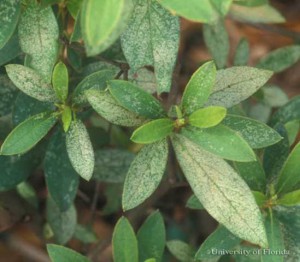
Damage caused by azalea lace bug. Photo credit: James Castner, UF/IFAS
When azaleas are in a garden, azalea lace bugs are sure to follow. The good news is these insects, that discolor the leaves of azaleas, can be controlled.
Lace bugs live on the underside of leaves and damage their hosts by piercing leaves with their straw-like mouthparts and removing the plant’s juices. Infested leaves have tiny yellow spots on the top surface and are discolored with dark, varnish-like excrement and old insect parts on the underside. Azalea plants begin to look unhealthy as insect numbers increase through spring and summer.
Azalea lace bugs spend winter as eggs on the underside of azalea leaves. They hatch in early to mid-March and then begin to feed and develop into adults.
Lace bugs complete their first generation by late April. They increase in number throughout the remainder of spring, summer and fall. These insects can complete three to five generations in a single growing season. In late September adult lace bugs, in their final generation of the season, lay eggs that will carry the population through winter.
The key to easily controlling azalea lace bugs is to properly time control efforts.
Inspect plants in early spring to see if insects are present. Look for leaves that are whitish to yellow on the top surface (they may be mottled in appearance) and have small, dark, varnish-like spots on the undersides. If leave damage is heavy continue to check plants every week for small lace bugs, which should begin to be visible in late March through April.
Early to mid spring is the best time to control the first generation of the bugs. Proper insecticide application timing will reduce need for further sprays during the rest of the growing season.
Insecticidal soap, horticultural oil, neem oil and most synthetic insecticides provide good control of lace bugs on azaleas. When using these types of chemicals, make sure to spray the backs of the leaves.
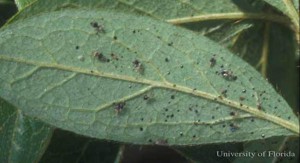
Azalea leaf with lace bugs. Photo Credit: James Castner, UF/IFAS
Systemic insecticides available for use against lace bugs include dinotefuran (Safari), imidacloprid (Bayer Advanced Tree & Shrub Insect Control, Merit) and acephate (Lilly Miller Ready-to-Use Systemic, Orthene). When properly applied, one application may provide season long control.
When using any chemical treatment on plants, it’s best to apply the product during early morning or late evening under cooler temperatures but never during the heat of the day or when the plant is in full sun. And always follow instructions on the pesticide label concerning mixing, application and safety precautions.
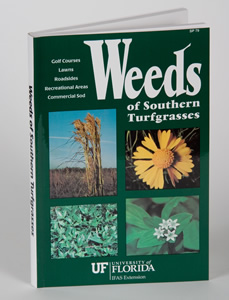
by Taylor Vandiver | Aug 3, 2015
As our world and our lives become more centered on technology it seems that all the information we need is just a touch screen away. After all, you are most likely reading this article from a laptop, smart phone, or tablet. While convenient and portable, there are some places you might not wish to take your electronics and one of those places is in the garden. You may say, “Well Taylor, that’s what they make waterproof, shatterproof, dirt proof, etc. cases for!” and I would say that you’re right. However, technology has many limiting factors such as battery life and screen glare. Now believe me, I am by no means disparaging technology! I come from a generation that considers Wi-Fi as necessary as water and an outlet comparable to oxygen. But there is something to be said for having a book in hand when out in the garden. For one thing your neighbors won’t worry about you as they see you march around the garden with your phone in the air doing the “No Signal Dance”. Also, a book is great to have in order for you to jot down any notes or reflections. I would like to list for you a few books that I often reference when I receive calls from homeowners. These books will cover various topics and all of them can be found on the UF/IFAS Bookstore website, the links for each can be found below. If you have any questions contact your local Extension Office and, as always, feel free to contact me and I can give you a rundown on my collection of favorite reference books!
- New to the UF/IFAS bookstore: “Trees: North & Central Florida” a field guide to 140 common tree species. This sturdy, pocket-sized field guide–the only one of its kind for north and central Florida–is designed for landscape professionals, arborists, naturalists, gardeners, and anyone seeking to know the trees around them. Full color photographs of leaves, bark, flowers and full trees, together with clear descriptions and other information make identifying trees easier than ever. This book also features a handy diagnostic key, an introduction to plant parts, a glossary and a ruler to guide you, whether you’re a trained botanist or a complete beginner.
- “Poisonous Plants of the Southern United States” John W. Everest, Thomas A. Powe, Jr., and John D. Freeman (of Auburn University). Identification of common poisonous plants found along fence lines and in pastures in the Southern United States.
- “Weeds of Southern Turfgrasses” This practical weed identification guide contains 427 color photographs of 193 weed species, their geographical range, and life cycle descriptions. Includes a glossary of taxonomic terms and index of common and scientific names.

- “Disorders and Diseases of Ornamental Palms” Recently revised and updated, this ID deck is a diagnostic tool for landscape professionals and backyard hobbyists. The color photographs and explanatory text helps users identify and distinguish between the nutritional deficiencies, physiological disorders and common diseases of ornamental palms. All palms in the U.S. suffer from disorders and diseases, and identifying the differences can be tricky. These cards feature photographs and descriptions and are cross-referenced for easy comparison between different symptoms and the potential problems causing them. Includes a table of contents and 55 laminated, ring-bound cards.
- “Florida Lawn Handbook: Best Management Practices for Your Home Lawn in Florida” Written in practical language by turfgrass experts, this highly-anticipated new edition offers the most current lawn management information. Color plates identify various grass types, weeds, diseases, and insects—including those that are good for your lawn! Chapters cover selection, establishment, and maintenance for each type of lawn; soil analysis and fertilization; yearly calendars for lawn care and culture; mowing, watering, and calibrating sprinkler systems and fertilizer spreaders; overseeding for winter color; preparing a lawn for drought and low temperatures; safe pesticide application and use; the latest integrated pest management strategies; organic lawn care; and complete, illustrated diagnostic information for weeds, diseases, insect problems, nematodes, and other pests.

- “Sustainable Gardening for Florida” Gardeners today face a unique challenge: how do you create a beautiful, thriving landscape without over-use of fertilizers, pesticides, and water? Sustainable Gardening for Florida might be the first place to look for answers. This book provides interesting, money-saving ideas to reduce your ecological footprint. It includes chapters on composting and mulching, integrated pest management, water-wise irrigation and rainwater harvesting, preparing your garden for disasters, and all aspects of managing meadows, lawns, trees and shrubs, edible gardens, rain gardens and waterfront gardening.
- “Vegetable Gardening in Florida” From James Stephens, the founder of the Florida Master Gardener Program, this is the one resource you need to successfully grow vegetables in Florida. Whether you’re growing beans, tomatoes, herbs, or any other Florida crop, this guide will take you from site selection and insect management through the harvest and storage of your produce. Useful planting guides, gardening measurement conversions, and organic gardening information are accented with full-color throughout.
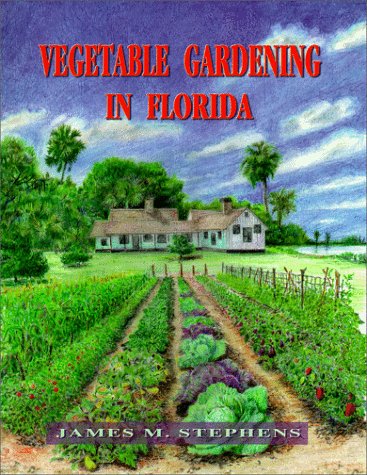
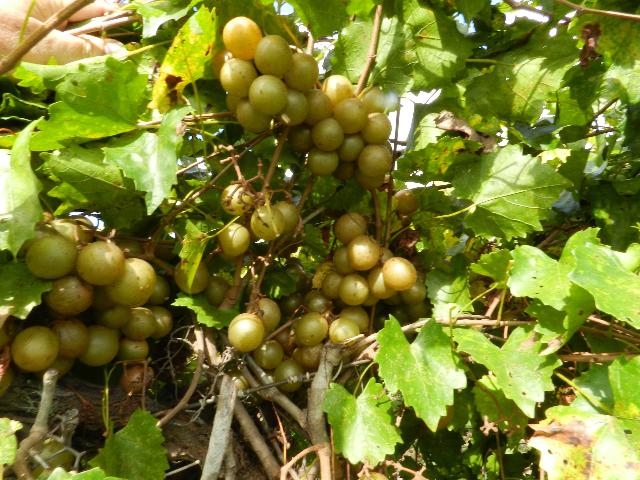
by Matthew Orwat | Aug 3, 2015

Muscadine cluster Credit: Peter C. Andersen, UF/IFAS Extension
Muscadines are a terrific grapey treat this time of year ’till fall throughout North Florida. To grow muscadines well in the home garden, care must be taken when pruning to maximize spatial efficiency and yield.
August is the very beginning of the muscadine harvest in the Florida Panhandle, which may last until October. Therefore it is also the time to begin thinking about pruning.
Once harvest concludes, it is usually a gardeners’ natural inclination to immediately prune their muscadine vines. This fast action is not the best for plant condition and next year’s yield, especially if there is an early frost. Early frosts surprise the plant before sugars have been moved to the roots for storage during dormancy. Therefore, waiting to prune in mid January to mid March will ensure that the vine has had adequate time to go dormant and acclimate to the winter season. A good rule of thumb is to wait to prune until bud swell or even first leaves emerge. This will greatly reduce the chance that vines are damaged by late frosts.
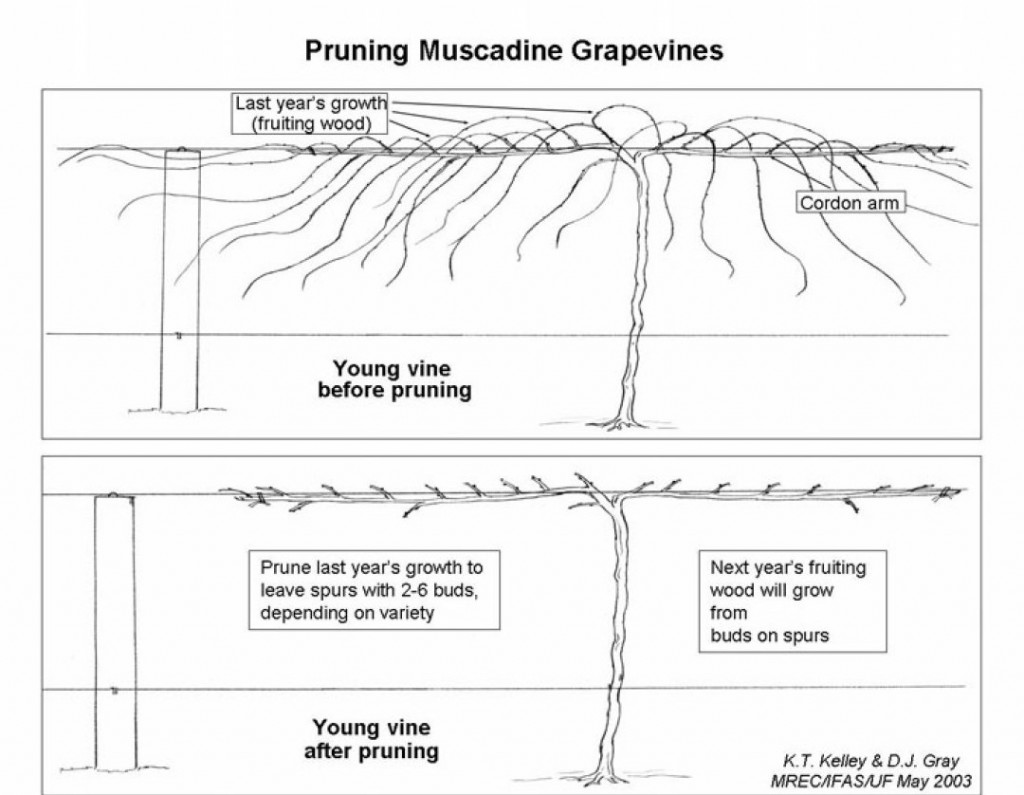
K.T. Kelly and JH. D. Gray, MREC/ UF/IFAS Extension 2003
Muscadines flower and fruit on shoots from current, not previous, years growth. These new bearing shoots arise from the leaf axils of the previous years’ growth. Pictured above is the bi-lateral cordon training system. This is the most popular system for muscadine production. Pruning must be performed to maintain this configuration. If vines are too vigorous, it is acceptable to prune lightly throughout the growing season.
Vines must also be trimmed before herbicide application at least 2 feet from the ground. Nonselective systemic herbicides don’t harm tissue with bark, but must not come in contact with green tissue or it will be translocated to the roots and damage the plant.
Using a bi-lateral cordon system, there are two main branches or “cordons” of the vine. Along each cordon, fruiting spurs should be spaced approximately every six inches. Each fruiting spur should contain 2-4 nodes.
If fruiting spurs become more than one foot from the cordon, it is time for spur renewal. This is typically done every 3-6 years. Entire spurs can be removed if they lose productivity and replaced by new shoots. Additionally, cordons may lose productivity or die off after 5 to 10 years of production. If this occurs, simply remove the cordon and train a new or existing branch into a new cordon.
Pruning with a design in mind and at the proper time will enhance performance and longevity of muscadines in the home garden.
Information from this article was derived from HS763 The Muscadine Grape

by Alex Bolques | Jul 28, 2015
Most likely, we all have them-garden pots. These typically are made of plastic, clay or wood. Garden pots should be sanitized if they were previously used or if they exhibit signs of mold or fungal growth. Whether they are used as garden boxes, planters, or hanging baskets, the surfaces of garden pots can harbor disease organisms, along with unsightly stains and mineral salts deposits. Salts from hard water and fertilizers can leach though clay pots leaving a white film on the pot’s outer surface. Salts accumulation can become flaky and encrusted around the rim and drainage holes of plastic and clay containers.

Mold or fungal growth on an unglazed terra-cotta (clay) pot Photo Credits: Alex Bolques, FAMU Research
To clean clay or plastic containers, use a brush or fine steel wool to remove dirt and debris and wash with a liquid soap detergent. If stains persist, consider using a 50:50 solution of water and vinegar. To sterilize clay or plastic pots, soak them in a mild solution of bleach, 1:10 bleach to water, for about 30 minutes. Then, immerse them in clean water and allow them to dry completely. Containers made of wood are different. If the timber that they are made of is not treated properly, they tend to rot and can harbor disease spores or bacteria. It is best to replace these as they show signs of wear or deterioration. Sanitizing your garden pots will help you avoid unwanted disease problems and unsightly garden container pots.
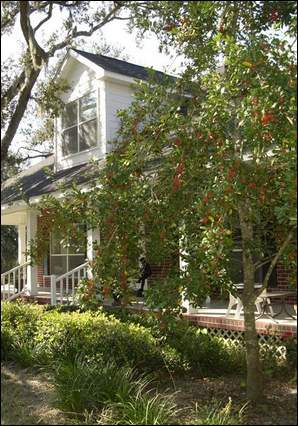
by Carrie Stevenson | Jul 27, 2015
Late summer brings hot, humid temperatures, and many Floridians are retreating from the heat into their air-conditioned homes. Unfortunately, those comforts of home also come with a price tag. When people think about energy efficiency, practices like turning off lights, purchasing energy-efficient appliances, good insulation and windows, and managing A/C temperature settings are the first things that come to mind. These are very important steps to take, not only to save money but also to conserve energy. The US Department of Energy has an excellent publication that can take you step-by-step through a home evaluation, and many energy companies offer a similar walk-through energy audit for free.
However, there are many best management practices that can be done outdoors to offset expensive home power bills. Planting trees is one example. Department of Energy studies have shown that when compared to a home in full sun, a shaded home may experience up to a 25% decrease in energy for cooling.
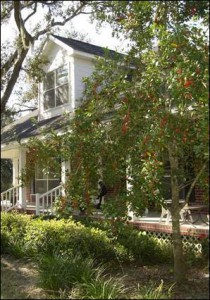
This home uses passive cooling from a front porch and numerous shade trees. Photo credit: Carrie Stevenson
Trees planted to shade eastern and western facing walls of your home can be the most effective, as these areas receive direct sun in the morning and afternoon. By preventing heat from entering your home, you prevent straining an air conditioning system that would otherwise have to counteract that heat. It is also helpful to provide shade over an air conditioning unit. Deciduous trees are ideal, as they have leaves to provide shade in the summer but drop them by winter, when you might want sunlight to passively heat your home.
In addition to shade, transpiration—the process of plants emitting moisture as they release water from leaf pores—creates cool spaces around vegetation. Grasses and shrubs along the edges of a home, or vines on nearby trellises, can cool walls and windows in this manner.
Finally, consider sprinkler systems. A home irrigation system can use a significant amount of energy to pump water throughout your yard. Calibrating your system and even reducing run time or frequency can also conserve water and reduce water bills.
For more information on energy-efficient landscaping, please visit www.myfloridahomeenergy.com or contact your local Extension office.











